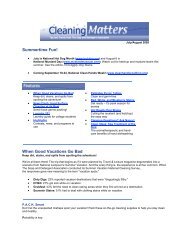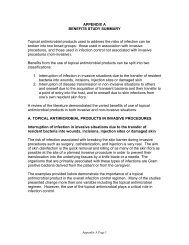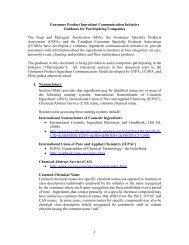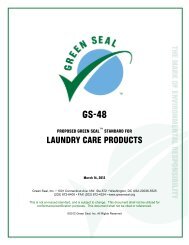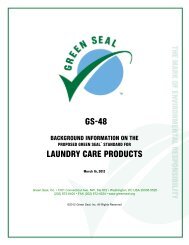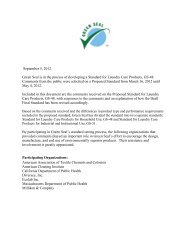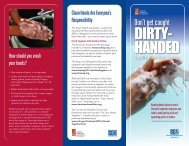subchapter c -- federal hazardous substances act regulations
subchapter c -- federal hazardous substances act regulations
subchapter c -- federal hazardous substances act regulations
You also want an ePaper? Increase the reach of your titles
YUMPU automatically turns print PDFs into web optimized ePapers that Google loves.
16 CFR Ch. II (1–1–05 Edition) – proposed modification – 6/25/06<br />
§ 1500.121 Labeling requirements;<br />
prominence, placement, and<br />
conspicuousness.<br />
(a)(1) Background and scope. Section<br />
2(p)(1) of the Federal Hazardous Substances<br />
Act (FHSA) or ”the Act”), 15 U.S.C.<br />
1261(p)(1), requires that <strong>hazardous</strong> <strong>substances</strong><br />
bear certain cautionary statements on their<br />
labels. These statements include: signal<br />
words; affirmative statements of the principal<br />
hazard(s) associated with a <strong>hazardous</strong><br />
substance; the common or usual name, or<br />
chemical name, of the <strong>hazardous</strong> substance;<br />
the name and place of business of the<br />
manuf<strong>act</strong>urer, packer, distributor, or seller;<br />
statements of precautionary measures to<br />
follow; instructions, when appropriate, for<br />
special handling and storage; the statement<br />
”Keep Out of the Reach of Children” or its<br />
pr<strong>act</strong>ical equivalent; and, when appropriate,<br />
first-aid instructions. Section 2(p)(2) of the<br />
Act specifies that all such statements shall be<br />
located prominently on the label of such a<br />
substance and shall appear in conspicuous and<br />
legible type in contrast by typography, layout,<br />
or color with other printed matter on the label.<br />
This regulation contains the Commission’s<br />
interpretations and policies for the type size<br />
and placement of cautionary material on the<br />
labels of <strong>hazardous</strong> <strong>substances</strong> and contains<br />
other criteria for such cautionary statements<br />
that are acceptable to the Commission as<br />
satisfying section 2(p)(2) of the Act. Labels<br />
that do not comply with this regulation may be<br />
considered misbranded.<br />
(2) Definitions. For the purposes of this<br />
section:<br />
(i) Container means the immediate<br />
package from which a <strong>hazardous</strong> substance<br />
may be dispensed and also any article, package<br />
or wrapping, such as a tube or cone used for a<br />
firework or a wet cell battery casing<br />
containing sulfuric acid, which is necessary for<br />
the substance to function during <strong>act</strong>ual use.<br />
(ii) Cautionary material, cautionary<br />
labeling, and cautionary labeling required by<br />
the Act mean all items of labeling information<br />
required by sections 2(p)(1) of the FHSA<br />
(repeated in 16 CFR 1500.3(b)(14)(i),<br />
supplemented in 16 CFR 1500.3(c)(10) or by<br />
the <strong>regulations</strong> which require additional<br />
labeling under section 3(b) of the Act.<br />
(iii) Display panel means any surface of the<br />
immediate container, and of any outer<br />
container or wrapping, which bears labeling.<br />
(iv) Principal display panel means the<br />
portion(s) of the surface of the immediate<br />
container, and of any outer container or<br />
wrapping, which bear(s) the labeling designed<br />
to be most prominently displayed, shown,<br />
presented, or examined under conditions of<br />
retail sale. (See paragraph (c)(1) of this<br />
section.)<br />
(v) Type size means the <strong>act</strong>ual height of the<br />
printed image of each upper case or capital<br />
letter as it appears on the label of a <strong>hazardous</strong><br />
substance. (See paragraph (c)(2) of this<br />
section.)<br />
(vi) Signal word means the appropriate<br />
word ”DANGER“ or ”WARNING,“ as<br />
specified in Table I of this section.<br />
(vii) Statement of principal hazard(s)<br />
means that wording descriptive of the principal<br />
or primary hazard(s) associated with a<br />
<strong>hazardous</strong> substance required by section<br />
2(p)(1)(E) of the Act and supplemented in 16<br />
CFR 1500.3(c)(10). Standardized texts for<br />
these statements, which are specific to each<br />
hazard and category of hazard, are included in<br />
Table I of this section.<br />
(viii) Pictogram means a graphical<br />
composition that includes a symbol plus other<br />
graphic elements, such as a border,<br />
background pattern or color that is intended to<br />
convey specific information. Pictograms,<br />
which are specific to each hazard and category<br />
of hazard, are included in Table I of this<br />
section. Pictograms should be in the shape of<br />
a square set at a point, should have a black<br />
symbol on a white background with a red<br />
frame sufficiently wide to be clearly visible,<br />
and should be the same height (measured from<br />
top point to bottom point) as the signal word,<br />
as specified in paragraph (c)(2) of this section.<br />
Deleted: ,<br />
Deleted: or ”CAUTION,“ as required<br />
by sections 2(p)(1) (C) or (D) of the Act.<br />
Deleted: Some examples of such<br />
statements are ”HARMFUL OR FATAL<br />
IF SWALLOWED,“ ”VAPOR<br />
HARMFUL,“ ”FLAMMABLE,“ and<br />
”SKIN AND EYE IRRITANT.”<br />
Table I –Labeling Requirments for Different Hazards<br />
Hazard Category Pictogram Signal<br />
Word<br />
-- 78 --<br />
Statement of Hazard



